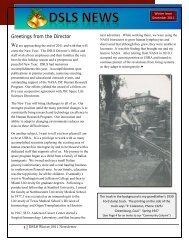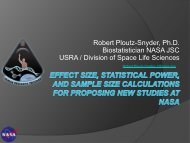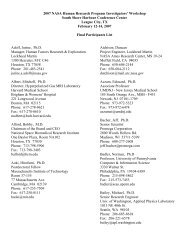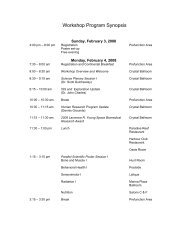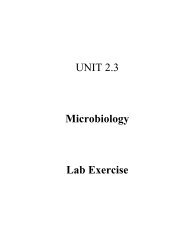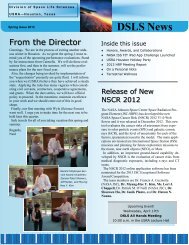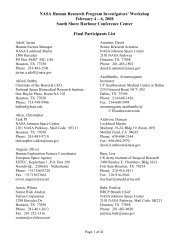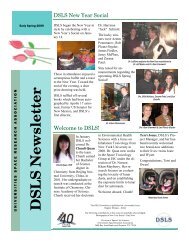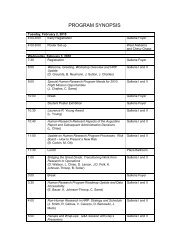Slides in PDF format
Slides in PDF format
Slides in PDF format
Create successful ePaper yourself
Turn your PDF publications into a flip-book with our unique Google optimized e-Paper software.
ACCELERATION TOLERANCE:<br />
WHAT HELPS AND WHAT HURTS<br />
Ulf Balld<strong>in</strong>, M.D., Ph.D., Dr.h.c., FAsM<br />
Senior Scientist<br />
Wyle Laboratories<br />
at<br />
Air Force Research Laboratory<br />
Brooks City-Base, Texas
ACCELERATION TOLERANCE<br />
• G-tolerance<br />
• G-endurance<br />
• Vision loss<br />
• G-<strong>in</strong>duced loss of consciousness<br />
• G-<strong>in</strong>duced almost loss of consciousness
A NEGLECTED PROBLEM<br />
ACCELERATION-INDUCED<br />
ALMOST LOSS OF<br />
CONSCIOUSNESS<br />
(A-LOC)
• Loss of consciousness dur<strong>in</strong>g high-G (G-<br />
LOC) is recognized as a major risk for<br />
fighter pilots<br />
• Much less attention is paid to the possibility<br />
that acceleration may produce<br />
neurocognitive effects without reach<strong>in</strong>g the<br />
threshold for frank loss of consciousness
Brooks City-Base, Texas<br />
A study was made to develop measures of<br />
A-LOC and to identify centrifuge profiles,<br />
which produce more prolonged A-LOC.<br />
Of 58 centrifuge runs, 37 produced evidence<br />
of A-LOC and three resulted <strong>in</strong> G-LOC.
A-LOC<br />
The subjects often reported:<br />
- difficulty <strong>in</strong> th<strong>in</strong>k<strong>in</strong>g<br />
- loss of memory<br />
- visual changes other than gray- and<br />
black-out<br />
- hear<strong>in</strong>g loss
A-LOC Symptoms and signs<br />
Difficulty th<strong>in</strong>k<strong>in</strong>g, could not concentrate,<br />
did not remember<br />
Visual changes – flash<strong>in</strong>g colors, rotat<strong>in</strong>g<br />
visual field with vection<br />
Hear<strong>in</strong>g loss/impairment 16<br />
Twitch<strong>in</strong>g of the face, hands, or feet 12<br />
Impaired motor control; <strong>in</strong>ability to act,<br />
ma<strong>in</strong>ta<strong>in</strong> control<br />
Felt ‘slow’; i.e., temporal distortion 4<br />
Lightheaded 3<br />
Frequency<br />
34<br />
21<br />
5
What helps:<br />
1. A correct Muscle and Respiratory Stra<strong>in</strong><strong>in</strong>g Maneuver<br />
2. Anti-G suit, especially with full coverage of the lower body and<br />
possibly with a cont<strong>in</strong>uous ready pressure<br />
3. Pressure breath<strong>in</strong>g dur<strong>in</strong>g G, unassisted for short G exposures<br />
and assisted pressure breath<strong>in</strong>g for endurance<br />
4. Muscle strength tra<strong>in</strong><strong>in</strong>g program and physical endurance<br />
tra<strong>in</strong><strong>in</strong>g (however, evidence difficult to scientifically prove)<br />
5. Avoid physical and mental fatigue before fly<strong>in</strong>g<br />
6. Avoid heat stress and dehydration<br />
7. Avoid low blood sugar concentration<br />
8. Regular high G-exposures<br />
9. Good health before fly<strong>in</strong>g<br />
10. Tilted seat back angle and elevated legs
What hurts:<br />
1. Not used to high G exposures<br />
2. Poorly timed anti-G stra<strong>in</strong><strong>in</strong>g maneuver<br />
3. Not properly fit anti-G suit<br />
4. Mask leakage when pressure breath<strong>in</strong>g dur<strong>in</strong>g G<br />
5. High body temperature and dehydration<br />
6. Low blood sugar concentration<br />
7. Fatigue and m<strong>in</strong>or illness<br />
8. Tall body length with long heart-bra<strong>in</strong> distance<br />
9. Upright seat position<br />
10. Hang-over
(from K. Gill<strong>in</strong>gham, MD, PhD)
(from K.Gill<strong>in</strong>gham, MD, PhD)
G-Layoff effect (from K.Gill<strong>in</strong>gham, MD, PhD)
Seat back angle and G-tolerance (from HJ van Beck)
Muscle strength tra<strong>in</strong><strong>in</strong>g<br />
programs to enhance G-<br />
tolerance and endurance.<br />
Muscle strength tra<strong>in</strong><strong>in</strong>g<br />
programs to enhance G-<br />
Evidences difficult to<br />
scientifically prove.<br />
tolerance and endurance
Muscle strength tra<strong>in</strong><strong>in</strong>g programs<br />
to <strong>in</strong>crease G-endurance<br />
Epperson WL, Burton RR,Bernauer EM. The <strong>in</strong>fluence of differential physical condition<strong>in</strong>g<br />
regimes on simulated aerial combat maneruver<strong>in</strong>g tolerance. Aviat. Space Environ. Med.<br />
1982 ; 53:1091-7<br />
and<br />
Tesch PA, Hjort H, Balld<strong>in</strong> UI. Effects of Strength Tra<strong>in</strong><strong>in</strong>g on G Tolerance. Aviat. Space<br />
Environ. Med. 1983; 54:691-5, :<br />
SACM time <strong>in</strong> 11-12 weeks of strength tra<strong>in</strong><strong>in</strong>g <strong>in</strong> centrifuge subjects or 11 fighter pilots<br />
<strong>in</strong>creased by 20-40%<br />
----------------------------------------------------------------------------------------------------------------------<br />
Rusko H, Kuronen P, Tesch P, Balld<strong>in</strong> U. The effects of a tra<strong>in</strong><strong>in</strong>g program on physical<br />
fitness and G-tolerance of pilots. Ann Med Milit Fenn 1990; 65:61-68:<br />
SACM time <strong>in</strong>creased from the second controls <strong>in</strong> 17 fighter pilots by 24% after 6 months of<br />
physical tra<strong>in</strong><strong>in</strong>g and by 38 % after 12 months of tra<strong>in</strong><strong>in</strong>g
Abdom<strong>in</strong>al muscle strength tra<strong>in</strong><strong>in</strong>g only<br />
Balld<strong>in</strong> UI, Myhre K, Tesch P, Wilhelmsen U,<br />
Andersen HT. Isometric abdom<strong>in</strong>al muscle tra<strong>in</strong><strong>in</strong>g and<br />
G-tolerance. Aviat. Space Environ. Med. 1985;<br />
56:120-4:<br />
No <strong>in</strong>crease <strong>in</strong> G-tolerance of fighter pilots was found<br />
with muscle strength tra<strong>in</strong><strong>in</strong>g of abdom<strong>in</strong>al muscles<br />
only.
PRESSURE BREATHING<br />
DURING G<br />
• AUGMENTS ACCELERATION<br />
TOLERANCE and ENDURANCE<br />
• USED IN USAF F-16 AND F-15<br />
(COMBAT EDGE)
PRESSURE BREATHING DURING<br />
G IN COMBINATION WITH<br />
EXTENDED COVERAGE ANTI-G<br />
SUIT<br />
• AUGMENTS ACCELERATION<br />
TOLERANCE STILL FURTHER<br />
• USED IN SWEDISH AIR FORCE GRIPEN<br />
AND IN FINNISH AIR FORCE F-18<br />
• USAF F-22 AND EUROFIGHTER
9 -<br />
8 -<br />
7 -<br />
6 -<br />
G z<br />
5 -<br />
4 -<br />
3 -<br />
2 -<br />
1 -<br />
GOR to +9Gz max<br />
2 m<strong>in</strong><br />
rest<br />
+4.5 to +7Gz SACM<br />
4 peaks max<br />
2 m<strong>in</strong><br />
rest<br />
“TACM”<br />
4 x 2-peak cycles (max)<br />
2 m<strong>in</strong><br />
rest<br />
+5 to +9Gz<br />
4 peaks max<br />
20<br />
m<strong>in</strong><br />
rest<br />
repeat<br />
whole<br />
sequence<br />
2 times
Incidences of G-LOC<br />
and relaxed G-tolerance<br />
G-LOC Mean max G<br />
dur<strong>in</strong>g GOR<br />
• CE/ATAGS 0 7.8<br />
• Standard anti-G suit 4 6.1<br />
(p
Mean heart rate, peripheral light loss % and<br />
effort level at the end of sortie three with<br />
CE/ATAGS and standard anti-G suit (STD)<br />
Profile/ensemble HR PLL Effort level<br />
.5-7 SACM CE/ATAGS 140 24 4.5<br />
STD 166* 53* 7.0*<br />
ACM CE/ATAGS 151 46 6.5<br />
STD 173* 66* 8.7*<br />
-9 SACM CE/ATAGS 156 33 6.0<br />
STD 169 (ns) 63* 9.3*
Mean subjective fatigue and reported<br />
recovery time with CE/ATAGS and<br />
USAF standard anti-G suit (STD)<br />
Subjective fatigue Recovery time<br />
(lower value more fatigue)<br />
• CE/ATAGS 3.8 units 21 hr<br />
• STD<br />
2.6 units 42 hr<br />
(p=0.001) (p=0.003)
ENDURANCE DURING MULTIPLE<br />
INTENSE HIGH +Gz EXPOSURES WITH<br />
EFFICIENT ANTI-G PROTECTION<br />
EQUIPMENT<br />
.<br />
UI Balld<strong>in</strong> 1, 2 , PM Werchan 1 , J French 1 ,<br />
B Self 1 , A Tong 3 .<br />
1<br />
Biodynamics and Protection Division, Air Force Research Laboratory, Brooks AFB, Texas;<br />
2<br />
National Defence Research Establishment, Sweden; 3 Currently USAF Senior Exchange<br />
Officer, Japan Air Self Defense Aeromedical Laboratory, Japan<br />
.
In a war time scenario<br />
pilots may be required to<br />
fly multiple missions<br />
dur<strong>in</strong>g the same day
OBJECTIVE<br />
ARE MULTIPLE STRENUOUS SORTIES<br />
WITH SEVERAL DOG-FIGHT LIKE ENGAMENTS<br />
INCLUDING PEAKS UP TO +9 Gz<br />
ENDURABLE<br />
WITHIN A 4-HR PERIOD<br />
USING<br />
COMBAT EDGE & ATAGS
METHODS<br />
AFRL centrifuge at Brooks AFB<br />
(6 G/s onset rate)<br />
9 subjects:<br />
COMBAT EDGE & ATAGS
Brooks City-Base
one engagement<br />
<br />
+ 9 G z<br />
+ 8 G z<br />
+ 5 G z<br />
+ 4 G z<br />
+ 1.5 G z<br />
80 sec
5 sorties with 4 engagements each<br />
1<br />
30 m<strong>in</strong><br />
2<br />
30 m<strong>in</strong><br />
3<br />
30 m<strong>in</strong><br />
4<br />
30 m<strong>in</strong><br />
5<br />
5<br />
m<strong>in</strong><br />
5<br />
m<strong>in</strong><br />
5<br />
m<strong>in</strong><br />
5<br />
m<strong>in</strong><br />
5<br />
m<strong>in</strong><br />
5<br />
m<strong>in</strong><br />
5<br />
m<strong>in</strong><br />
5<br />
m<strong>in</strong><br />
5<br />
m<strong>in</strong><br />
5<br />
m<strong>in</strong><br />
5<br />
m<strong>in</strong><br />
5<br />
m<strong>in</strong><br />
5<br />
m<strong>in</strong><br />
5<br />
m<strong>in</strong><br />
5<br />
m<strong>in</strong>
RESULTS<br />
• 7 of 9 subjects endured all 5 sorties<br />
• 3 G-LOCs (2 <strong>in</strong> the same subject)<br />
• 4 A-LOCs
MAXIMUM EFFORT LEVEL<br />
Maximum Effort Level<br />
10<br />
8<br />
6<br />
4<br />
2<br />
0<br />
1 2 3 4 5 6 7 8 9 Mean<br />
Subject
HIGHEST RECORDED PERIPHERAL LIGHT LOSS<br />
Peripheral Light Loss (%)<br />
100<br />
80<br />
60<br />
40<br />
20<br />
0<br />
1 2 3 4 5 6 7 8 9 Mean<br />
Subject
HIGHEST RECORDED CENTRAL LIGHT LOSS<br />
Central Light Loss (%)<br />
100<br />
80<br />
60<br />
40<br />
20<br />
0<br />
1 2 3 4 5 6 7 8 9 Mean<br />
Subject
MAXIMAL HEART RATE<br />
Max Heart Rate (bpm)<br />
180<br />
160<br />
140<br />
120<br />
100<br />
80<br />
60<br />
40<br />
20<br />
0<br />
1 2 3 4 5 6 7 8 9 Mean<br />
Subject
MINIMAL OXYGEN SATURATION<br />
M<strong>in</strong> Oxygen Saturation (%)<br />
100<br />
80<br />
60<br />
40<br />
20<br />
0<br />
1 2 3 4 5 6 7 8 9 Mean<br />
Subject
SUBJECTIVE RECOVERY TIME<br />
Recovery Time (hours)<br />
50<br />
40<br />
30<br />
20<br />
10<br />
0<br />
1 2 3 4 5 6 7 8 9 M ean<br />
Subject
CONCLUSION<br />
Subjects can withstand five consecutive<br />
high <strong>in</strong>tensive air-to-air combat sorties<br />
with<br />
PBG and extended coverage anti-G suit
QUESTIONS HAVE BEEN RAISED IF<br />
PRESSURE BREATHING DURING G<br />
IN COMBINATION WITH<br />
EXTENDED<br />
COVERAGE ANTI-G SUIT<br />
COULD INCREASE THE RISK OF CARDIAC<br />
DYSRHYTHMIAS
9 -<br />
8 -<br />
7 -<br />
6 -<br />
G z<br />
5 -<br />
4 -<br />
3 -<br />
2 -<br />
1 -<br />
GOR to +9Gz max<br />
2 m<strong>in</strong><br />
rest<br />
+4.5 to +7Gz SACM<br />
4 peaks max<br />
2 m<strong>in</strong><br />
rest<br />
“TACM”<br />
4 x 2-peak cycles (max)<br />
2 m<strong>in</strong><br />
rest<br />
+5 to +9Gz<br />
4 peaks max<br />
20<br />
m<strong>in</strong><br />
rest<br />
repeat<br />
whole<br />
sequence<br />
2 times
RESULTS<br />
No PVCs dur<strong>in</strong>g GOR<br />
In all SACMs and TACMs together:<br />
- 157 PVCs with Standard Equipment<br />
- 156 PVCs with COMBAT EDGE and<br />
ATAGS
CONCLUSIONS<br />
• NO DIFFERENCE WAS SHOWN IN THE<br />
OCCURRENCE OF PVCs BETWEEN<br />
STANDARD ANTI-G SUIT AND COMBAT<br />
EDGE WITH ATAGS EQUIPMENT WITH THE<br />
SELECTED AIRWAY AND G-TROUSER<br />
PRESSURES<br />
• ALL CARDIAC DYSRHYTHMIAS<br />
DISAPPEARED AFTER THE HIGH G-LOADS
Conclusion<br />
This survey <strong>in</strong>dicated that<br />
+G z -<strong>in</strong>duced arm pa<strong>in</strong> is less of a<br />
problem <strong>in</strong>-flight than it is <strong>in</strong> the<br />
centrifuge. However, as more than<br />
50% of the fighter pilots <strong>in</strong> the<br />
Swedish Air Force sometimes have<br />
experienced arm pa<strong>in</strong> <strong>in</strong> flight, it is<br />
still a problem to be taken <strong>in</strong>to<br />
consideration.
PRESSURIZED<br />
ARM SLEEVES AND GLOVES<br />
FOR PROTECTION AGAINST<br />
G-INDUCED ARM PAIN<br />
U lf I. B alld<strong>in</strong>, M .D ., Ph.D . 1, 2) , B rian P. Self, Ph.D . 1) ,<br />
R obert M . Shaffstall, M .S. 3) , T hom as R . M organ, Ph.D . 1)<br />
)<br />
Biodynamics and Protection Division, Air Force Research Laboratory,<br />
Brooks AFB, Texas; 2) N ational D efence R esearch Establishm ent,<br />
Sweden and 3) W yle Laboratories, Brooks AFB, Texas
COMPLAINTS OF ARM PAIN<br />
at high susta<strong>in</strong>ed +G z among Swedish fighter pilots<br />
Dur<strong>in</strong>g high +G z flight (<strong>in</strong> Swedish Air Force’s Viggen and Gripen<br />
fighter aircraft)<br />
In centrifuge exposures (AFRL Centrifuge tests at Brooks Air Force<br />
Base, Texas)
Presumed causes of G-<strong>in</strong>duced arm<br />
pa<strong>in</strong><br />
• Similar to causes of G-<strong>in</strong>duced petechiae<br />
• Raised venous hydrostatic pressure<br />
• Increased transmural pressure<br />
• Over-distention of blood vessels
PRESSURIZED ARM SLEEVES and GLOVES for PROTECTION aga<strong>in</strong>st<br />
G-INDUCED ARM and HAND PAIN
Sleeve and glove pressure<br />
schedules<br />
mHg<br />
80<br />
70<br />
60<br />
50<br />
40<br />
30<br />
20<br />
10<br />
0<br />
1G 4G 9G<br />
80 mmHg<br />
60 mmHg<br />
40 mmHg
Subject wear<strong>in</strong>g COMBAT EDGE, ATAGS, pressurized sleeves and<br />
gloves seated <strong>in</strong> the AFRL centrifuge with his hands on the throttle and<br />
control stick as <strong>in</strong> a Gripen fighter cockpit
PAIN LEVEL<br />
G-<strong>in</strong>duced arm and hand pa<strong>in</strong> usually started above +6 G z<br />
and was often the reason for term<strong>in</strong>ation of the G-exposure<br />
without the pressurized sleeves and gloves<br />
The pressurized sleeves and gloves significantly (p
11<br />
Pa<strong>in</strong> Level - Left Arm<br />
10<br />
9<br />
8<br />
7<br />
6<br />
5<br />
4<br />
3<br />
2<br />
0 mmHg<br />
40 mmHg<br />
60 mmHg<br />
80 mmHg<br />
1<br />
0<br />
GOR 3 4 5 6 7 8 9<br />
G Exposure<br />
Figure 4. Average subjective left arm pa<strong>in</strong> scores for the gradual<br />
onset rate (GOR) and exposures from 3 - 9 Gz.
Pa<strong>in</strong> Level - SACM<br />
10 Pa<strong>in</strong> Left<br />
Pa<strong>in</strong> Right<br />
8<br />
6<br />
4<br />
2<br />
0<br />
CONTROL 40 mmHg 60 mmHg 80 mmHg<br />
Figure 5. Pa<strong>in</strong> levels for the left and right arms dur<strong>in</strong>g the SACM runs.<br />
Pa<strong>in</strong> levels dur<strong>in</strong>g the CONTROL were significantly higher than all other conditions.
CONCLUSION<br />
The pressurized sleeves and gloves appear to<br />
alleviate and sometimes elim<strong>in</strong>ate G-<strong>in</strong>duced<br />
arm and hand pa<strong>in</strong><br />
Pressurization level (40 - 80 mm Hg) did not<br />
seem to alter the results
Foot pa<strong>in</strong> due to extended periods at high G<br />
and lack of counter-pressure to the feet<br />
-measles
G-measles on the<br />
uncovered back
Dehydration and G-endurance<br />
• Balld<strong>in</strong> UI, Sporrong A, Tesch PA. Rehydration and G-<br />
tolerance, psychomotor performance and muscle<br />
function. Aerospace Medical Association Annual<br />
Scientific Meet<strong>in</strong>g. Aviat. Space Environ. Med. 1984;<br />
55:467:<br />
A 3% dehydration may decrease G-<br />
endurance measured as the ability to<br />
withstand repeated 15-s periods at +3.5<br />
and 5 G with normal body temperature<br />
by about 40%.
HEAT STRESS-INDUCED DEHYDRATION<br />
AND DETERIORATION IN<br />
ACCELERATION-TOLERANCE<br />
BALLDIN UI, O’CONNOR RB, ISDAHL WM,<br />
WERCHAN PM, MORGAN TR, STORK RL
Thermal Chamber
THIS STUDY WAS ACCOMPLISHED TO<br />
DETERMINE HEAT STRESS AND<br />
DEHYDRATION IN SIMULATED<br />
FLIGHT OPERATIONS OF HOT AND<br />
HUMID DAYS USING ANTI-G SUIT<br />
FLIGHT EQUIPMENT WITHOUT<br />
PRESSURE BREATHING
12 subjects (6 fighter aircrew and 6 Brooks<br />
AFB centrifuge subjects)<br />
USAF standard anti-G suit CSU-13B/P<br />
(without pressure breath<strong>in</strong>g dur<strong>in</strong>g G) and<br />
other ord<strong>in</strong>ary flight equipment
CENTRIFUGE EXPOSURES<br />
– Gradual onset (0.1 G/s), relaxed without stra<strong>in</strong><strong>in</strong>g<br />
maneuvers to loss of peripheral or central vision<br />
– Rapid onset (6.0 G/s), relaxed without stra<strong>in</strong><strong>in</strong>g<br />
maneuvers to 3, 4, 5, 6, 7, 8 or 9 G <strong>in</strong> periods of 15 s<br />
with 2 m<strong>in</strong> rest periods <strong>in</strong> between to loss of<br />
peripheral or central vision
HEAT LOAD and EXERCISE <strong>in</strong><br />
the THERMAL CHAMBER<br />
• Ambient temperature 35°C (95 °F)<br />
• Relative humidity 85%<br />
• Radiant heat black globe temperature 50 °C (122<br />
°F)<br />
• Walk<strong>in</strong>g on level treadmill at 4 km/hr (2.5 mph)<br />
for 20 m<strong>in</strong><br />
• Gradual cool<strong>in</strong>g to room air and relative<br />
humidity dur<strong>in</strong>g a 20 m<strong>in</strong> period, while sitt<strong>in</strong>g <strong>in</strong><br />
an aircraft seat
Mean Core Temperature and<br />
Heat Score<br />
38.2<br />
4<br />
Core Temperature °C<br />
38<br />
37.8<br />
37.6<br />
3<br />
2<br />
1<br />
Subjective Heat Scores<br />
Core Temp<br />
Heat Score<br />
37.4<br />
5 M<strong>in</strong> 15 m<strong>in</strong> 25 m<strong>in</strong> 35 m<strong>in</strong> 45 m<strong>in</strong><br />
0<br />
Treadmill<br />
Start<br />
Treadmill<br />
stopped.<br />
Heat<br />
lamps<br />
off.<br />
Start Cool<strong>in</strong>g
Mean Chest/Back Sk<strong>in</strong> Temperatures<br />
and Heat Score<br />
4<br />
38<br />
37.6<br />
3<br />
Temperature °C<br />
37.2<br />
36.8<br />
36.4<br />
2<br />
1<br />
Subjective Heat Scores<br />
Chest Temp<br />
Back Temp<br />
Heat Score<br />
36<br />
35.6<br />
5 M<strong>in</strong> 15 m<strong>in</strong> 25 m<strong>in</strong> 35 m<strong>in</strong> 45 m<strong>in</strong><br />
0<br />
Treadmill<br />
Start<br />
Treadmill<br />
stopped.<br />
Heat<br />
lamps<br />
off.<br />
Start Cool<strong>in</strong>g
Mean sweat loss was<br />
1.1 liter ±0.3<br />
correspond<strong>in</strong>g to 1.3% ±0.2 loss of<br />
body weight
BLOOD SAMPLES
BLOOD SAMPLES<br />
HEMOGLOBIN <strong>in</strong>creased from 15.2<br />
G/DL±0.9 to 15.6 G/DL ±0.9 (p
G-tolerance<br />
Max atta<strong>in</strong>ed relaxed gradual onset G<br />
– before heat stress 7.1 G±0.8<br />
– after heat stress 6.3 G±0.9<br />
(p
Track<strong>in</strong>g Task
F-16 FLIGHT SIMULATION<br />
TRACKING TEST<br />
No statistically significant differences<br />
were found <strong>in</strong>:<br />
•RMS(Root Mean Square of the G-level<br />
error)<br />
• Time on Target dur<strong>in</strong>g tests before and<br />
after heat stress
CONCLUSIONS<br />
• The heat load used caused significantly<br />
<strong>in</strong>creased body and sk<strong>in</strong> temperatures,<br />
and a significant dehydration (revealed<br />
by fluid loss and blood chemistry)<br />
• The heat load caused significantly<br />
decreased relaxed G-tolerance and<br />
significantly <strong>in</strong>creased heart rate dur<strong>in</strong>g<br />
rapid onset G<br />
• Flight simulation performance measures<br />
were not impaired after heat stress
RECOMMENDATIONS<br />
– The pilot should be aware of the dangers of heat load.<br />
Be encouraged to ma<strong>in</strong>ta<strong>in</strong> hydration<br />
– Avoid excessive heat exposure dur<strong>in</strong>g pre-flight<br />
transportation to the aircraft and dur<strong>in</strong>g pre-flight<br />
walk-around <strong>in</strong>spections of the aircraft<br />
– Use hangars or sun shades to protect the aircraft when<br />
parked before take-off <strong>in</strong> hot climate
What helps:<br />
1. A correct Muscle and Respiratory Stra<strong>in</strong><strong>in</strong>g Maneuver<br />
2. Anti-G suit, especially with full coverage of the lower body and<br />
possibly with a cont<strong>in</strong>uous ready pressure<br />
3. Pressure breath<strong>in</strong>g dur<strong>in</strong>g G, unassisted for short G exposures<br />
and assisted pressure breath<strong>in</strong>g for endurance<br />
4. Muscle strength tra<strong>in</strong><strong>in</strong>g program and physical endurance<br />
tra<strong>in</strong><strong>in</strong>g (however, evidence difficult to scientifically prove)<br />
5. Avoid physical and mental fatigue before fly<strong>in</strong>g<br />
6. Avoid heat stress and dehydration<br />
7. Avoid low blood sugar concentration<br />
8. Regular high G-exposures<br />
9. Good health before fly<strong>in</strong>g<br />
10. Tilted seat back angle and elevated legs
What hurts:<br />
1. Not used to high G exposures<br />
2. Poorly timed anti-G stra<strong>in</strong><strong>in</strong>g maneuver<br />
3. Not properly fit anti-G suit<br />
4. Mask leakage when pressure breath<strong>in</strong>g dur<strong>in</strong>g G<br />
5. High body temperature and dehydration<br />
6. Low blood sugar concentration<br />
7. Fatigue and m<strong>in</strong>or illness<br />
8. Tall body length with long heart-bra<strong>in</strong> distance<br />
9. Upright seat position<br />
10. Hang-over
ACCELERATION TOLERANCE:<br />
WHAT HELPS AND WHAT HURTS<br />
Ulf Balld<strong>in</strong>, M.D., Ph.D., Dr.h.c., FAsM<br />
Senior Scientist<br />
Wyle Laboratories<br />
at<br />
Air Force Research Laboratory<br />
Brooks City-Base, Texas



